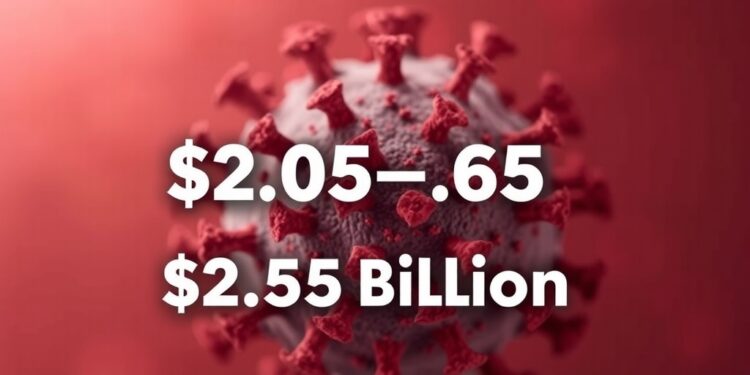The ongoing repercussions of the COVID-19 pandemic are becoming increasingly evident, with emerging studies revealing the severe economic implications of long COVID on American society. A recent investigation spearheaded by researchers from the CUNY Graduate School of Public Health and Health Policy, alongside Baylor College of Medicine, has quantified the financial burden associated with long COVID. This debilitating condition represents a significant public health crisis that is causing losses predominantly through reduced workplace productivity, alongside direct healthcare costs, creating a ripple effect that impacts everyone within the healthcare system and economy.
According to this comprehensive study published in the Journal of Infectious Diseases, the estimated annual cost of long COVID cases in the United States ranges from $2.01 billion to $6.56 billion. At the core of this analysis lies a sophisticated computer simulation model developed by the Public Health Informatics, Computational, and Operations Research (PHICOR) team at CUNY. This model illustrates the fate of an individual infected with the SARS-CoV-2 virus, calculating the probability of developing long COVID, along with the range of symptoms that may emerge over time.
The findings underscore the extensive economic toll associated with long COVID, where each individual case incurs costs between $5,084 and $11,646 annually. The model indicates that an alarming 95 percent of these costs arise from productivity losses, highlighting that absenteeism alone accounts for about 25 percent of these losses. This phenomenon of presenteeism, where employees attend work but operate at diminished capacity, further exacerbates the economic ramifications faced by businesses across the nation.
The computational model worked by simulating over 44.69 million to 48.04 million cases of long COVID currently afflicting Americans. The staggering statistics reflect an ongoing public health crisis, with a notable projection that, based on a conservative estimate of 6 percent of those infected with COVID-19 experiencing long COVID, the economic burden is bound to escalate significantly. Should the prevalence rate increase to even 10 percent, the annual societal costs could soar to approximately $3.34 billion.
The implications of these findings are far-reaching. Professor Bruce Y. Lee, the study’s senior author, asserts that the repercussions extend beyond immediate healthcare costs and into the fabric of our economy. As companies grapple with decreased productivity, the financial strain inevitably trickles down to insurance premiums and taxes, placing additional burdens on individuals and families.
Long COVID presents a complex challenge, as it encompasses a myriad of symptoms that persist long after the initial infection has resolved. The intersection of chronic illnesses and infectious diseases has revealed an unforeseen aspect of COVID-19’s legacy, wherein substantial long-term disabilities pose risks that may ultimately outstrip the immediate death toll and hospitalization impacts the world has faced since the onset of the pandemic. This reality heightens the urgency for public health strategies aimed at addressing the chronic sequelae resulting from COVID-19 infections.
Continued investigations are crucial to grasp the full magnitude of long COVID’s burden on society. Co-author Dr. Peter J. Hotez emphasizes the necessity to focus on this constellation of chronic conditions which may well outlast the immediate effects of the virus itself. The health systems and policymakers are urged to prioritize resources and develop effective interventions to support those affected by long COVID.
The authors also acknowledge the limitations associated with existing estimates tied to long COVID. Expert evaluations suggest that as much as 20 percent of individuals infected with the coronavirus may develop long-lasting symptoms, indicating that the true extent of the socioeconomic impacts could be substantially underestimated. The prospect of an extended healthcare response to a growing population of individuals dealing with long-lasting COVID complications could stretch resources thin and necessitate innovative approaches to care and support.
In an era marked by a global pandemic, such findings should catalyze proactive measures by both public health institutions and individual stakeholders. With potential implications for healthcare inequities, investment in research addressing long COVID is imperative. Addressing these issues is not solely about improving health outcomes for those affected; it is also about safeguarding the economic stability of communities across the nation.
As societies mobilize around the core public health and workforce realities introduced by the pandemic, collective action becomes essential to mitigate the challenges posed by long COVID. An informed governance and collaborative research efforts can buffer the adverse effects of a malady that threatens to destabilize economies while simultaneously compromising individual health. Together, we can work toward a future wherein the burdens of long COVID are alleviated through understanding, awareness, and determined innovation in healthcare systems.
As research progresses, stakeholders must stay attuned to evolving data and insights pertaining to long COVID. Empowering individuals with knowledge, access to resources, and ongoing care must be at the forefront of public health responses. Ultimately, the findings presented in this recent study should serve as a clarion call for action to refine the strategies used to combat not only the acute effects of COVID-19 but also its chronic implications.
In light of the ongoing evolution of the COVID-19 pandemic, embracing a comprehensive public health approach to manage long COVID will be critical. By fostering a society that emphasizes health equity, supports research and innovation, and recognizes the multifaceted challenges posed by both acute and chronic illness, communities can pave the way towards recovery, healing, and a brighter collective future.
Subject of Research: Economic Impact of Long COVID in the United States
Article Title: The Current and Future Burden of Long COVID in the United States
News Publication Date: March 19, 2025
Web References: Journal of Infectious Diseases
References: Bartsch, S., Chin, K. L., Strych, U., John, D. C., Shah, T. D., Bottazzi, M. E., O’Shea, K. J., Robertson, M., Weatherwax, C., Heneghan, J., Martinez, M. F., Ciciriello, A., Kulkarni, S., Velmurugan, K., Dibbs, A., Scannell, S. A., Shen, Y., Nash, D., Hotez, P. J., Lee, B. Y. (2025). The Current and Future Burden of Long COVID in the United States. The Journal of Infectious Diseases.
Image Credits: N/A
Keywords: Long COVID, Economic Impact, Public Health, Health Care Costs, Productivity Losses




